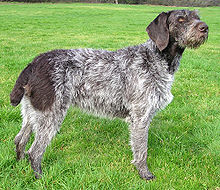German Wirehaired Pointer

German Wirehaired Pointer
|
||||||||||||||||||||||||||
| Other names | Deutsch Drahthaar Deutscher Drahthaariger Vorstehhund Drahthaar |
|||||||||||||||||||||||||
|---|---|---|---|---|---|---|---|---|---|---|---|---|---|---|---|---|---|---|---|---|---|---|---|---|---|---|
| Origin | Germany | |||||||||||||||||||||||||
|
||||||||||||||||||||||||||
|
||||||||||||||||||||||||||
| Domestic dog (Canis lupus familiaris) | ||||||||||||||||||||||||||
| Traits | |||
|---|---|---|---|
| Life span | average 9-12 years | ||
| Classification / standards | |||
|---|---|---|---|
| FCI | Group 7, Section 1.1 Continental Pointing Dogs: Pointer type #98 | standard | |
| AKC | Sporting | standard | |
| ANKC | Group 3 (Gundogs) | standard | |
| CKC | Group 1 - Sporting Dogs | standard | |
| KC (UK) | Gundog | standard | |
| NZKC | Gundog | standard | |
| UKC | Gun Dog | standard | |
The German Wirehaired Pointer is a medium to large-sized griffon type breed of dog developed in the 19th century in Germany for hunting. It became a leading gun dog in Germany in the later part of the 20th century. It is the result of the careful mixing and crossing of the griffon, Deutscher Stichelhaar, Deutscher Kurzhaar, and the hunting Pudelpointer in the late 19th century.
The German Wirehaired pointer is a well muscled, medium to large-sized dog of distinctive appearance. Balanced in size and sturdily built, the breed's most distinguishing characteristics are its weather resistant, wire-like coat and its facial furnishings. Typically pointer in character and style, the German wirehaired pointer is an intelligent, energetic and determined hunter. The tail is typically docked to two-fifths of the natural length. In countries where docking is prohibited the tail should be of sufficient length to reach down to the hocks. Like all German pointers, they have webbed feet. This dog is sometimes confused with the Spinone Italiano.
The functional wiry coat is the breed's most distinctive feature. A dog must have a correct coat to be of correct type. The coat is weather resistant and water-repellent. The undercoat is dense enough in winter to insulate against the cold but is so thin in summer as to be almost invisible. The distinctive outer coat is straight, harsh, wiry and flat lying, and is from one to two inches in length. The outer coat is long enough to protect against the punishment of rough cover, but not so long as to hide the outline of the dog. On the lower legs the coat is shorter and between the toes it is of softer texture. On the skull the coat is naturally short and close fitting. Over the shoulders and around the tail it is very dense and heavy. The tail is nicely coated, particularly on the underside, but devoid of feather. Eyebrows are of strong, straight hair. Beard and whiskers are medium length. The hairs in the liver patches of a liver and white dog may be shorter than the white hairs. A short smooth coat, a soft woolly coat, or an excessively long coat is to be severely penalized when showing. While maintaining a harsh, wiry texture, the puppy coat may be shorter than that of an adult coat. The coat of the puppy should be shorter than 1 inch the adult coat should be kept at 1 inch long.
The dog should be evaluated at a moderate gait. The movement is free and smooth with good reach in the forequarters and good driving power in the hindquarters. The topline should remain firm.
...
Wikipedia
